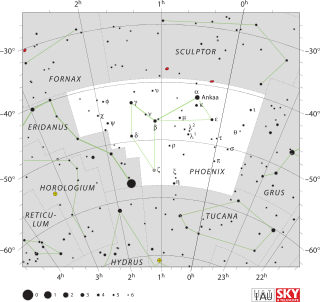
Phoenix is a minor constellation in the southern sky. Named after the mythical phoenix, it was first depicted on a celestial atlas by Johann Bayer in his 1603 Uranometria. The French explorer and astronomer Nicolas Louis de Lacaille charted the brighter stars and gave their Bayer designations in 1756. The constellation stretches from roughly −39° to −57° declination, and from 23.5h to 2.5h of right ascension. The constellations Phoenix, Grus, Pavo and Tucana, are known as the Southern Birds.

Delta Scuti, Latinized from δ Scuti, is a variable star in the southern constellation Scutum. With an apparent visual magnitude that fluctuates around 4.72, it is the fifth-brightest star in this small and otherwise undistinguished constellation. Analysis of the parallax measurements place this star at a distance of about 199 light-years from Earth. It is drifting closer with a radial velocity of −45 km/s.
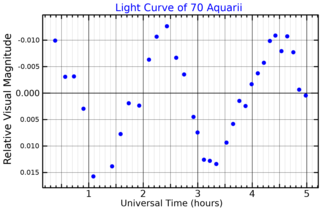
70 Aquarii is a variable star located 425 light years away from the Sun in the equatorial constellation of Aquarius. It has the variable star designation FM Aquarii; 70 Aquarii is the Flamsteed designation. It is near the lower limit of visibility to the naked eye, appearing as a dim, yellow-white hued star with a baseline apparent visual magnitude of 6.19. This star is moving closer to the Earth with a heliocentric radial velocity of –5.8 km/s.
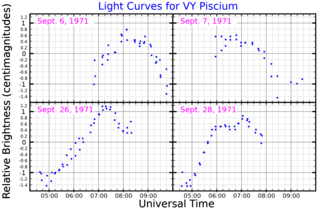
HR 515 is a variable star in the zodiac constellation of Pisces, near the eastern constellation border with Aries. Before the constellation borders were officially set, it held the Flamsteed designation of 3 Arietis, abbreviated 3 Ari). This star has the variable star designation VY Piscium, or VY Psc for short. It is a white-hued star that is near the lower limit of visibility to the naked eye with an apparent visual magnitude that ranges from 6.54 down to 6.59. Parallax measurements provide a distance estimate of approximately 503 light years from the Sun.

59 Aurigae, often abbreviated as 59 Aur, is a star in the constellation Auriga. Its baseline apparent magnitude is 6.1, meaning it can just barely be seen with the naked eye as a dim, yellow-white hued star. Based on parallax measurements, it is located about 483 light-years away from the Sun.
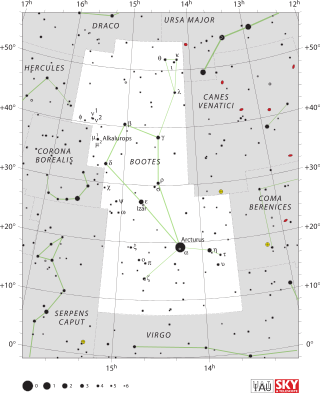
Kappa Boötis is a double star in the constellation Boötes. It has the traditional name Asellus Tertius and the Flamsteed designation 17 Boötis. The components are separated by an angular distance of 13.5 arcsec, viewable in a small telescope. Kappa Boötis is approximately 155 light years from Earth.

V352 Aurigae is a variable star in the northern constellation of Auriga. It dimly visible to the naked eye with an apparent visual magnitude that ranges from 6.13 down to 6.18. According to the Bortle scale, it is faintly visible to the naked eye from dark rural skies. The star is located at a distance of approximately 970 light years from the Sun based on parallax, but is drifting closer with a radial velocity of −7 km/s.
CP Boötis is a yellow-white hued star in the northern constellation of Boötes. With a baseline apparent visual magnitude of 6.40, it is at or near the lower limit for visibility with the typical naked eye in good viewing conditions. The distance to this star can be estimated from its annual parallax shift of 12.91 mas, which yields a range of 252.6 light years. It is moving further away with a heliocentric radial velocity of +5.9 km/s.

An SX Phoenicis variable is a type of variable star. These stars exhibit a short period pulsation behavior that varies on time scales of 0.03–0.08 days. They have spectral classifications in the range A2-F5 and vary in magnitude by up to 0.7. Compared to the Sun, these stars have a lower metallicity, which means they have a reduced abundance of elements other than hydrogen and helium. They also have relatively high space velocity and low luminosities for stars of their stellar classification. These properties distinguish the SX Phoenicis variables from their cousins, the Delta Scuti variables. The latter have longer periods, higher metallicity and large amplitudes.

SX Phoenicis is a variable star in the southern constellation Phoenix. With an apparent visual magnitude ranging around 7.33, it is too faint to be readily seen with the naked eye and requires binoculars. It is located 272 light years from the Sun, as determined from an annual parallax shift of 12 mas.

V529 Andromedae, also known as HD 8801, is a variable star in the constellation of Andromeda. It has a 13th magnitude visual companion star 15" away, which is just a distant star on the same line of sight.
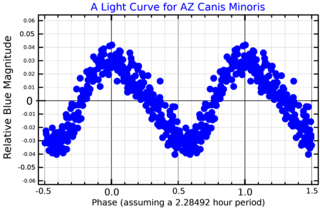
AZ Canis Minoris is a variable star in the equatorial constellation of Canis Minor. It is just visible to the naked eye in good viewing conditions as a dim, white-hued star with an apparent visual magnitude of around 6.46. The star is located around 500 light years away from the Sun based on parallax, and is drifting further away with a radial velocity of +15 km/s. No evidence has been found for a companion to this star, although in the past it has been reported as a binary star system.

Psi Phoenicis is a star in the constellation Phoenix. Its apparent magnitude varies from 4.3 to 4.5 with a period of about 30 days and it is approximately 342 light years away based on parallax.

UY Scuti (BD-12°5055) is an extreme red hypergiant or red supergiant star in the constellation Scutum. It is considered one of the largest known stars by radius and is also a pulsating variable star, with a maximum brightness of magnitude 8.29 and a minimum of magnitude 10.56. It has an estimated radius of 1,708 solar radii (1.188×109 kilometres; 7.94 astronomical units), thus a volume nearly 5 billion times that of the Sun. It is approximately 2.9 kiloparsecs (9,500 light-years) from Earth. If placed at the center of the Solar System, its photosphere would at least engulf the orbit of Jupiter.
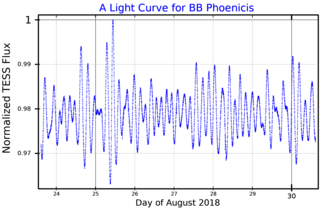
BB Phoenicis is a variable star in the constellation of Phoenix. It has an average visual apparent magnitude of 6.17, being visible to the naked eye with excellent viewing conditions. From parallax measurements by the Gaia spacecraft, it is located at a distance of 448 light-years from Earth. Its absolute magnitude is calculated at 0.6.

BD Phoenicis is a variable star in the constellation of Phoenix. From parallax measurements by the Gaia spacecraft, it is located at a distance of 256 light-years from Earth. Its absolute magnitude is calculated at 1.5.

Rho Phoenicis is a variable star in the constellation of Phoenix. From parallax measurements by the Gaia spacecraft, it is located at a distance of 245 light-years from Earth.
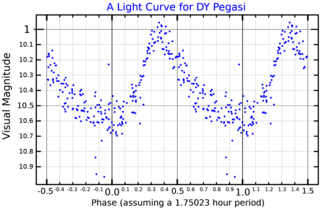
DY Pegasi, abbreviated DY Peg, is a binary star system in the northern constellation of Pegasus. It is a well-studied SX Phoenicis variable star with a brightness that ranges from an apparent visual magnitude of 9.95 down to 10.62 with a period of 1.75 hours. This system is much too faint to be seen with the naked eye, but can be viewed with large binoculars or a telescope. Based on its high space motion and low abundances of heavier elements, it is a population II star system.
HD 76270, also known as HR 3544, is a solitary, white hued star located in the southern circumpolar constellation Volans. It has an apparent magnitude of 6.10, making it faintly visible to the naked eye if viewed under ideal conditions. The object is relatively far with a distance of 2,360 light years, but is slowly approaching the Solar System with a heliocentric radial velocity of −2.6 km/s.

QQ Telescopii, also known as HD 185139 or simply QQ Tel, is a solitary variable star located in the southern constellation Telescopium. It has an apparent magnitude of 6.25, placing it near the limit for naked eye visibility, even under ideal conditions. Gaia DR3 parallax measurements imply a distance of 333 light years and it is currently receding with a heliocentric radial velocity of 7.8 km/s. At its current distance, QQ Telescopii's brightness is diminished by two tenths of a magnitude due to interstellar dust and it has an absolute magnitude of +1.01.

















